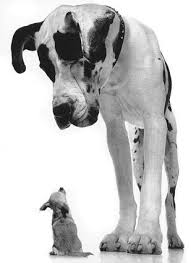TITAN DANES - GREAT DANE PUPPIES
History;
Dogs resembling the Great Dane have been seen on Egyptian monuments dating back to 3,000 BC.
Extremely large boarhounds resembling the Great Dane appear in ancient Greece; in frescoes from Tiryns dating back to 14th-13th centuries BC. The large boarhound or Molossian hound continues to appear throughout ancient Greece in subsequent centuries right up to the Hellenistic era. The Molossian hound, the Suliot dog and specific imports from Greece were used in the 18th century to increase the stature of the boarhounds in Austria and Germany and the wolfhounds in Ireland.
Bigger dogs are depicted on numerous runestones in Scandinavia, on coinage in Denmark from the 5th Century AD and in the collection of Old Norse poems, known in English as Poetic Edda. The University of Copenhagen Zoological Museum holds at least seven skeletons of very large hunting dogs, dating from the 5th Century BC going forward through to the year 1000 AD.
Name change;
In the 19th century, the dog was known as a "German boarhound" in English speaking countries. Some German breeders tried to introduce the names "German Dogge" and "German Mastiff" on the English market, because they believed the breed should be marketed as a dog of luxury and not as a working dog. However, due to the increasing tensions between Germany and other countries, the dog later became referred to as a "Great Dane", after the grand danois in Buffon's Histoire naturelle, générale et particulière in 1755.
Dogs resembling the Great Dane have been seen on Egyptian monuments dating back to 3,000 BC.
Extremely large boarhounds resembling the Great Dane appear in ancient Greece; in frescoes from Tiryns dating back to 14th-13th centuries BC. The large boarhound or Molossian hound continues to appear throughout ancient Greece in subsequent centuries right up to the Hellenistic era. The Molossian hound, the Suliot dog and specific imports from Greece were used in the 18th century to increase the stature of the boarhounds in Austria and Germany and the wolfhounds in Ireland.
Bigger dogs are depicted on numerous runestones in Scandinavia, on coinage in Denmark from the 5th Century AD and in the collection of Old Norse poems, known in English as Poetic Edda. The University of Copenhagen Zoological Museum holds at least seven skeletons of very large hunting dogs, dating from the 5th Century BC going forward through to the year 1000 AD.
Name change;
In the 19th century, the dog was known as a "German boarhound" in English speaking countries. Some German breeders tried to introduce the names "German Dogge" and "German Mastiff" on the English market, because they believed the breed should be marketed as a dog of luxury and not as a working dog. However, due to the increasing tensions between Germany and other countries, the dog later became referred to as a "Great Dane", after the grand danois in Buffon's Histoire naturelle, générale et particulière in 1755.

